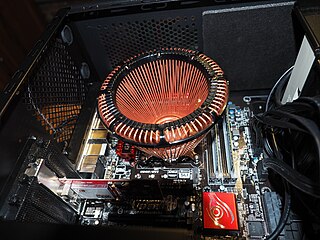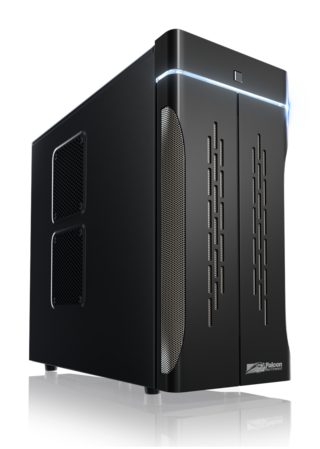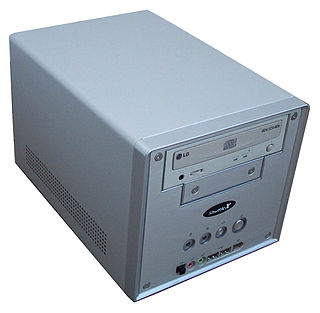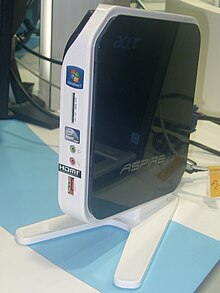
A motherboard is the main printed circuit board (PCB) in general-purpose computers and other expandable systems. It holds and allows communication between many of the crucial electronic components of a system, such as the central processing unit (CPU) and memory, and provides connectors for other peripherals. Unlike a backplane, a motherboard usually contains significant sub-systems, such as the central processor, the chipset's input/output and memory controllers, interface connectors, and other components integrated for general use.

A desktop computer is a personal computer designed for regular use at a stationary location on or near a desk due to its size and power requirements. The most common configuration has a case that houses the power supply, motherboard, disk storage ; a keyboard and mouse for input; and a monitor, speakers, and, often, a printer for output. The case may be oriented horizontally or vertically and placed either underneath, beside, or on top of a desk.

A quiet, silent or fanless PC is a personal computer that makes very little or no noise. Common uses for quiet PCs include video editing, sound mixing and home theater PCs, but noise reduction techniques can also be used to greatly reduce the noise from servers. There is currently no standard definition for a "quiet PC", and the term is generally not used in a business context, but by individuals and the businesses catering to them.

ATX is a motherboard and power supply configuration specification, patented by David Dent in 1995 at Intel, to improve on previous de facto standards like the AT design. It was the first major change in desktop computer enclosure, motherboard and power supply design in many years, improving standardization and interchangeability of parts. The specification defines the dimensions; the mounting points; the I/O panel; and the power and connector interfaces among a computer case, a motherboard, and a power supply.

Mini-ITX is a 170 mm × 170 mm motherboard form factor developed by VIA Technologies in 2001. Mini-ITX motherboards have been traditionally used in small-configured computer systems. Originally, Mini-ITX was a niche standard designed for fanless cooling with a low power consumption architecture, which made them useful for home theater PC systems, where fan noise can detract from the cinema experience.

BTX is a form factor for motherboards, originally intended to be the replacement for the aging ATX motherboard form factor in late 2004 and early 2005.

A computer case, also known as a computer chassis, is the enclosure that contains most of the hardware of a personal computer. The components housed inside the case are referred as the internal hardware, while hardware outside the case are known as peripherals.

In personal computing, a tower unit, or simply a tower, is a form factor of desktop computer case whose height is much greater than its width, thus having the appearance of an upstanding tower block, as opposed to a traditional "pizza box" computer case whose width is greater than its height and appears lying flat.

ThinkCentre is a brand for a family of business-oriented desktop computers, the early models of which were designed, developed and marketed by International Business Machines (IBM) since 2003. In 2005, IBM sold its PC business, including the ThinkCentre brand, to Lenovo. ThinkCentre computers typically include mid-range to high-end processors, options for discrete graphics cards, and multi-monitor support.

AOPEN is a major electronics manufacturer from Taiwan that makes computers and parts for computers. AOPEN used to be the Open System Business Unit of Acer Computer Inc. which designed, manufactured and sold computer components.

In computer design, microATX is a standard motherboard form factor introduced in December 1997. The maximum size of a microATX motherboard is 9.6 × 9.6 in (244 × 244 mm). However, there are examples of motherboards using microATX designation despite having a smaller size of 244 × 205 mm (9.6 × 8.1 in). The standard ATX size is 25% longer, at 12 × 9.6 in (305 × 244 mm).

Shuttle Inc. (TAIEX:2405) is a Taiwan-based manufacturer of motherboards, barebone computers, complete PC systems and monitors. Throughout the last 10 years, Shuttle has been one of the world's top 10 motherboard manufacturers, and gained fame in 2001 with the introduction of the Shuttle SV24, one of the world's first commercially successful small form factor computers. Shuttle XPC small form factor computers tend to be popular among PC enthusiasts and hobbyists, although in 2004 Shuttle started a campaign to become a brand name recognized by mainstream PC consumers.

A barebone computer is a partially assembled platform or an unassembled kit of computer parts allowing more customization and lower costs than a retail computer system. They are available for desktop computer, notebook and server purposes, and in nearly any form factor. Manufacturers are also able to produce systems of a specialized or non-standard form factor, since the system is sold as a pre-built unit, with the motherboard and power supply already installed.

In computer design, Pico-ITX is a PC motherboard form factor announced by VIA Technologies in January 2007 and demonstrated later the same year at CeBIT. The formfactor was transferred over to SFF-SIG in 2008. The Pico-ITX form factor specifications call for the board to be 10 × 7.2 cm (3.9 × 2.8 in), which is half the area of Nano-ITX.
In computing, the motherboard form factor is the specification of a motherboard – the dimensions, power supply type, location of mounting holes, number of ports on the back panel, etc. Specifically, in the IBM PC compatible industry, standard form factors ensure that parts are interchangeable across competing vendors and generations of technology, while in enterprise computing, form factors ensure that server modules fit into existing rackmount systems. Traditionally, the most significant specification is for that of the motherboard, which generally dictates the overall size of the case. Small form factors have been developed and implemented.

A mini PC is a small-sized, inexpensive, low-power, legacy-free desktop computer designed for basic tasks such as web browsing, accessing web-based applications, document processing, and audio/video playback.
Nvidia Ion was a product line of Nvidia Corporation intended for motherboards of low-cost portable computers. It used graphics processing units and chipsets intended for small products.

Mini ATX or Mini-ATX is a generic name that may be used by motherboard manufacturers to describe a small motherboard, and has been used by AOPEN in reference to a motherboard design with dimensions 15 × 15 cm (5.9 × 5.9 in).
Mini-STX is a computer motherboard form factor that was released by Intel in 2015.

On June 26, 2007, Dell released the new Inspiron desktop series, under the Dell Inspiron branding, as a replacement to the Dell Dimension desktop computers.






















